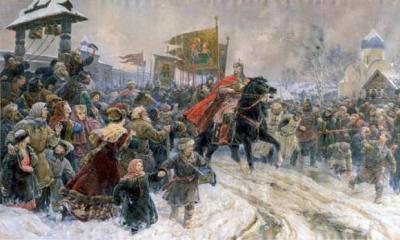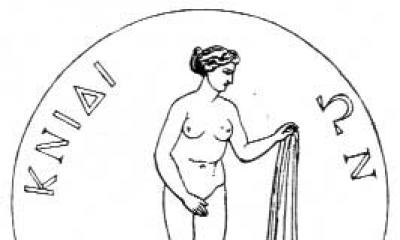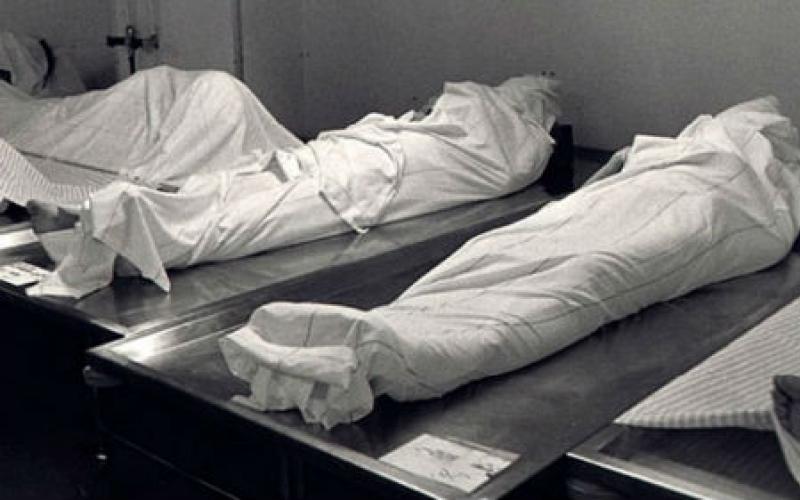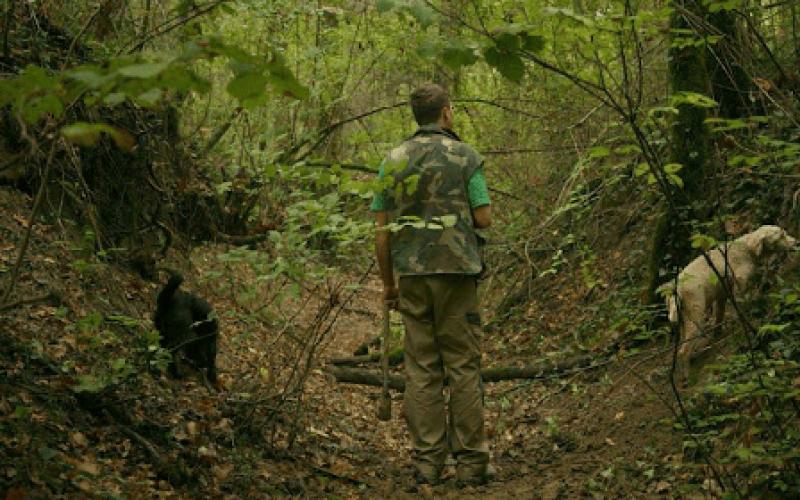The Mozyr Cathedral, which is under the protection of St. Michael the Archangel, escaped destruction in the 20th century, when many other churches were destroyed in a terrible time for the Church. It had its own goblet of sorrow. The ordeal was no less horrific. The holy place, where believers prayed for centuries, was destined to become a place of martyrdom for hundreds of innocent people. The cathedral in 1935 was transformed into a prison of the NKVD of the Polesye region, the center of which was Mozyr. According to incomplete data, more than two thousand death sentences were passed in this prison.
Indeed, it was a very sad time, including for the Mozyr region, - says Archpriest Alexander Lapushansky, which has been studying the archives of Minsk, Gomel, Mozyr for several years and collecting information about the history of the Mozyr Cathedral. - Our temple in the 20s of the last century was taken away from the Orthodox and given to the so-called "living church". Those who served there were popularly called "renovationists". This formation was organized by the Soviet authorities in order to destroy the Orthodox Church from within. The "living church" was served by priests who, for certain offenses, fell under certain church punishments, were deprived of the right to serve, and those who were dissatisfied with the official position of the Church. These outwardly looked like Orthodox priests, they could take away any temple with the help of the authorities. Thus, in the territory of the former Soviet Union about 70% of all parishes were withdrawn Orthodox Church. The same fate befell the St. Michael's Cathedral in Mozyr. People told about a certain "priest" Dudkin, who, when baptizing a child, held a cigarette in his mouth. When they made a remark to him, he answered something like this: "Be quiet, otherwise I will imprison you all." These people did not enjoy authority and therefore few believers went to the churches of the "living churchmen".
At this time, Bishop of Minsk and Turov Melchizedek drew attention to the priest John Pashin who was a diligent preacher. He was a widower, and Vladyka Melchizedek consecrated him to the rank of bishop at the Turov cathedra. Vladyka John became famous for traveling a lot and preaching everywhere. The power of his preaching was so great that the people ran to listen. Thanks to the authority of Bishop John, the Renovationist schism was destroyed on the territory of Mozyr Polissya.
Meanwhile, the Renovationist cathedra was then headed by Archbishop Petr Avdashkevich. And one day, in 1935, his body was found under the bell tower of St. Michael's Church. Official version: He made an attempt on his own life. But there were rumors that, in fact, Archbishop Peter was thrown from a height, since the tragedy happened just after Vladyka submitted a petition to the leadership of the Russian Orthodox Church to return to the bosom of true Orthodoxy. After this incident, the temple ceased to function in its capacity.
In 1935, as the townspeople recall, the temple was turned into a prison. The building adjoining the Mikhailovsky Cathedral (where the diocesan administration is now) has since housed the administration of the NKVD of the Polessky region. At first, only the lower floors were equipped as a prison, and later the cathedral itself became a prison. A huge number of people passed through this place of detention, according to incomplete data - about 5 thousand people. Almost all the Mozyr clergy were repressed. Father Lapushansky tells a story that the old-timers told him:
It can be said that our temple literally stands on the blood of martyrs who were killed without guilt. Many priests have gone through suffering. Each meter of the temple is connected with scary story. A lot of the remains of dead people were found in its cellars. In the room where candles are now sold, massive wooden doors with powerful locks have been preserved - from those very times. The door has a viewing window. Archpriest John Kaminsky, confessor of the diocese of Turov, who served in the church for about 40 years, told the following story about this room. He also found people who were in this prison. According to memoirs, during the retreat of the Soviet troops in 1941, everyone who was in prison was herded into this room and closed. They died there. But there is no documentary evidence of this.
People who lived near the cathedral said that they could not sleep at night - because of the hum of cars that brought sand. They and lime were sprinkled with the bodies of the executed people, who lay in piles. There were about 15 tons of earth in the cellars - almost up to the ceiling.
In fact, the dungeons moved to the church quite recently. By the beginning of 1993, there was no open access to them. When believers and priests got there, they saw a terrible picture: there were skeletons, human remains and a lot of garbage. During the post-war years, there was nothing in the temple building: a dairy plant, and an archive. There were many different workshops on the territory, and all the garbage was thrown into the cellar. A lot of earth was taken out of the cellars, all the remains were carefully collected and placed in the chapel in the same room where they are now buried. Two coffins now contain about 60 skulls and bones. In total, more than 2.5 thousand people were repressed in Mozyr and the Mozyr region.
There was a version that in fact the human remains belong to the Bernardine monks, who once founded their monastery here, continues the story of Archpriest Alexander Lapushansky. - But when we entered the cellars, everything here was Soviet. We have preserved machine-gun belts, rifle shells, Soviet pennies of the 30s ...
Now in the cleaned room - the crypt of St. Michael's Cathedral, on the site of the martyrdom of thousands of people - a lower church has been created, consecrated in honor of the New Martyrs and preachers. On Mondays, it is here that the liturgy is served - at dusk, by the light of candles and lamps. We told about the fate of one of the recently glorified martyrs, priest Alexy Mogilnitsky, in our newspaper (05/31/2011). Materials are being prepared for canonization about Priest Sazonov Savich, Archpriest Vladimir Serebryakov with his wife Lilia and others - those who shed their blood for Christ.
Newspaper "Zvyazda", original in Belarusian: http://zvyazda.minsk.by/ru/archive/article.php?id=83163
(Diocese of Turov, Belarus)
In the city of Mozyr, along Komsomolskaya Street, there is the cathedral of the diocese - the Cathedral in the name of the Archangel Michael.
In 1645, retired colonel Stefan Lozko built a small wooden monastery for the Bernardine monks, buying for this part of the hill opposite the castle. The temple was built as a late baroque church in the form of a two-towered three-aisled basilica.
In 1648, during the Cossack-Peasant War, the monastery was destroyed.
In 1745, the noble and wealthy Askerok family began the construction of a new stone Bernardine monastery, the center of which was to be a majestic cathedral, the construction of which was completed in the 60s or 70s of the 18th century. The temple, rectangular in plan, was divided inside by two rows of columns into three naves: a central one and two side ones.
The architecture of the cathedral corresponds to the Belarusian form of the basilica temples of the Baroque era. The main facade is a three-tier composition with two bell towers rising on the sides. The monastery also houses elementary School and a library. In the crypt of the church, a family burial vault was built, where representatives of the Askerok family were laid to rest.
At the end of the 18th century, when Belarus joined the Russian Empire, the Bernardine monastery was closed, and in its buildings the offices of the Mozyr district and the hospital were located. Repeated fires led the monastery building to significant destruction.
In 1864, the temple, which was in a deplorable state, was transferred to the Orthodox Church. The towers were rebuilt in the Russian manner in the spirit of classicism: triangular pediments and arched openings in rectangular niches.
On September 5, 1865, the temple was consecrated according to the Orthodox order in the name of the holy Archangel Michael with the right chapel in the name of St. Cyril of Turov.
During the revolutionary years, the Mozyr Cathedral of St. Michael the Archangel escaped the fate of the destroyed shrines, but from 1937 to 1941 it was turned into a prison of the NKVD of the Polessky region. According to incomplete data, more than 2,000 death sentences were handed down in this prison. In the crypt of the temple, the NKVD officers arranged a mass burial of the remains of those citizens who died under torture in the dungeons of the NKVD.

Icon of the Archangel Michael
In connection with the military events in 1941, the temple was reopened. In 1952, the temple was registered by the Soviet authorities, and repairs began.
In 1992, by order of the Synod of the Belarusian Orthodox Church, the ancient diocese of Turov was revived. At St. Michael's Cathedral, a department for working with youth, a missionary department, a department for studying the activities of sects and new religious movements were created.
The icon of the Mother of God "Tikhvinskaya" became a revered icon in St. Michael's Cathedral.
In 2006, during the cleaning of the crypt of an ancient temple, the remains of people were discovered. The remains were reburied according to church canons in the crypt, where parishioners began to come to pray to honor the memory of the executed.
Now, in the crypt of St. Michael's Cathedral, on the site of the martyrdom of thousands of people, a temple has been created in honor of the New Martyrs and Confessors who shone in the land of Polesie.

Altar in the crypt of St. Michael's Cathedral
On November 21, 2008, on the day of the celebration of the patronal feast of St. Michael's Cathedral, the Church Historical and Archaeological Cabinet was opened.

On November 21, 2010, on the day of the Council of the Archangel Michael of God, with the blessing of Bishop Stefan of Turov and Mozyr, the first Divine Liturgy was celebrated in the crypt church in honor of the New Martyrs and Confessors.
After Divine Liturgy Vladyka Exarch performed the rite of canonization
A photo: Cathedral Michael the Archangel
Photo and description
The Cathedral in the name of the Holy Archangel Michael is a functioning Orthodox church with an ancient history.
In 1645 retired colonel Stefan Lozko invited Bernardine monks to Mozyr. He built a wooden monastery for the Bernardines on land donated for the needs of the monastery. The middle of the 17th century was marked for the Belarusian land by wars and unrest. During this turbulent time, the entire city of Mozyr was practically wiped off the face of the earth. The Bernardine monastery did not survive either.
The restoration of Mozyr began only under the Grand Duke of Lithuania Jan III Sobessky in 1678, who ordered the city to be rebuilt. This monarch became famous for stopping the Muslim invasion of Europe. In 1745, the construction of a stone Bernardine monastery began. The construction was financed by the noble Mozyr family Askerok. The monastery was built in the late baroque style. The monastery complex also included a library and a school. In the crypt of the monastery, a tomb of the Askerok family was built.
After the uprising of the national liberation movement in the 19th century, the monastery was closed. Within its walls there is a city presence and a hospital. In 1864, after repeated fires, the city authorities decided to close the hospital and transfer the temple building to the Orthodox Church. After the repair, the temple was re-consecrated in honor of the holy Archangel Michael of God.
After the revolution of 1917, a terrible fate awaited the temple - an NKVD prison was set up in the prayer-filled walls of the monastery. Here the suicide bombers awaited their fate. More than 2,000 death sentences were handed down and carried out.
The cathedral was opened and re-consecrated during the Great Patriotic War. It practically did not close even in Soviet times. Officially, it has been a functioning Orthodox church since 1951.
Each city has its own history, its own face. At Mozyr, these are picturesque hills, along which winding streets wind intricately. Old houses shyly hide along the ravines, and ancient buildings stand proudly on the tops of the hills. One of these hills, or rather, part of it, was presented to the Bernardine monks in 1645 by retired colonel Stefan Lozko and a small wooden monastery complex was built for them. In 1648, during the peasant war, the monastery was destroyed. During the wars of the 17th century, Mozyr was practically wiped off the face of the earth. In 1678, the restoration of Mozyr began under the Grand Duke of Lithuania, Jan III Sobiesk. In 1760-1778. Marshal Kazimir Askerko "adbudavaў kastsel z grunt" in the late baroque style. The monastery complex also included an elementary school and a library. The church was consecrated in honor of Archangel Michael on July 16, 1775 by Bishop Felix Tovianovsky.
After the hard times of the end of the 17th century and the annexation of the Belarusian lands to the Russian Empire, the Bernardine monastery was closed in 1832. In the same year, the monastery building was given over to the offices of the Mozyr district, and from 1847 a hospital was located there. In 1851, after the fire, documentation (kashtarys) was drawn up for the conversion of the church into an Orthodox church. The reconstruction was completed only in 1865, on September 5 of this year the temple was consecrated according to the Orthodox order in honor of the holy archangel Michael of God. In the right aisle, an altar was consecrated in the name of St. Cyril of Turov, and in the unconsecrated left a sacristy, a library and an archive were located.
The temple was spared World War I and civil war. Being under the protection of the archangel of the heavenly host, the Mozyr Cathedral of St. Michael the Archangel was not destroyed. Another terrible test awaited him.
January 26, 1926 St. Michael's Cathedral was transferred to the department of schismatics - "living churchmen"; Renovationist Metropolitan, schismatic Daniel (Gromovenko) held secret negotiations with the OGPU and achieved the termination of the contract for the use of the church by the Orthodox community.
On February 10, 1928 St. Michael's Cathedral acquired the status of the cathedral of the newly formed Mozyr Renovation Diocese. Later, in 1933, a part of the cathedral was converted into a bulk station for grain. By the summer of 1937, the cathedral was finally closed and became a prison, first a district prison, and then a regional one. In the former monastery building, adjacent to the building of the temple, the NKVD department of the Polessky region was located, where "special troikas" interrogated and sentenced the prisoners. In the nave of the temple, along the perimeter, there were three-tiered bunks, on which prisoners were accommodated, several people per sunbed. An armed guard stood in the choir stalls of the church. It was forbidden to go to the center of the room; in case of violation, the guard fired without warning. There were also prison cells in the basements, some were sanitary: they buried those who died from hunger and disease.
The stories of eyewitnesses of those terrible days are shocking: the grandmother told the author of this article about the terrible screams that came from the basements of the cathedral at night. The crypt, where the tomb of the Askerok clan used to be, is covered with human bones covered with sand mixed with lime.
Today, as a sign of repentance and edification to the descendants, in the crypt of St. Michael's Cathedral, on the site of the martyrdom of hundreds of people, a church was built in honor of the new martyrs and confessors of the Belarusian land.
This is exactly what Patriarch Kirill spoke about in his speech on November 4, 2015. The Primate of the Russian Orthodox Church noted how important it is to remember the difficult 1930s, the injustice and blood of which “must never leave our memory,” and the suffering of our people in these years, according to the patriarch, “cannot be minimized”.
For the Russian Church, the sufferings of our people are not general words, but a very specific, personal tragedy for many of the New Martyrs, whose memory is carefully preserved in the Church. The 20th century cut off our historical religious memory not only at the national-state level, but also at the family level. A person often does not know his roots, does not know who his ancestors were, and feels like an abandoned orphan. The crypt temple in memory of the innocently killed on our earth is a reminder that each of us in heaven has a prayer book-patron. This is a reminder that our orphanhood is one-sided. We forget and deny God, but He does not deny us.
The Temple of the Lord, where prayers were offered to God for two hundred years, became a prison through which a huge number of people passed, according to incomplete data - about 5 thousand people. Almost all the clergy of the city and the Mozyr region were repressed. And today, many turned to the author of these lines to find out about the fate of their relatives, who once were taken away from their home forever. Unfortunately, the names of many martyrs and ascetics will remain unknown. Only the Lord knows each by name and will reward each according to their feat. They stand at the Throne of God, pray and intercede for us.
The crypt temple has an unusual forged iconostasis in the form of a prison lattice and a stone throne. On the right, there is a chapel-tomb, where the remains of the tortured and killed are buried, there are skulls with bullet holes. They speak more convincingly than all the documents about the murdered of our contemporaries, and not about the Bernardine monks, as some believe.
More than a hundred lamps are hung from the ceiling of the crypt in honor of the innocent victims during the years of repression; there is also the image of the "Savior of Chernobyl", written in prayerful memory of the dead liquidators of the consequences of the Chernobyl disaster.
During World War II, the cathedral was opened and remained active throughout the period of occupation. After the war, repeated attempts were made to close it, but by the grace of God, an Orthodox community was registered in 1951, and the temple was defended.
In the period from the end of the 19th century to the beginning of the 20th century, there were no significant changes in the architecture of the temple. However, the modern interior is not similar to the interior of the nineteenth century. Only architectural details have been preserved: cross-shaped double ceilings, wall pilasters, which adorn the amazingly beautiful paintings. In the 80s of the last century, the walls of the narthex and the northern nave were painted by the famous artist A. Isachev, his extraordinary paintings are known all over the world.
Today St. Michael's Cathedral is the spiritual center of the Orthodox life of the Diocese of Turov and a historical monument - the pearl of Polissya architecture.
At present, the cathedral stands, “dressed” in forests. The facade of the temple is being repaired, and upon completion of the work, it will acquire its original color. Today, in St. Michael's Cathedral, they will be very happy with your feasible financial assistance, dear residents of Mozyr! As never before, she will have to go to court now. More information is available on the website of the Turov diocese.
Tamara KOSHEVNIKOVA
Service Schedule:
Divine Liturgy
- on Monday at 8.00 in the lower church
- from Tuesday to Saturday at 8.00 in the upper temple
- Sunday - early at 7.00
- Sunday - late at 9.30
Evening worship
- daily at 17.00
Telephone:
375 236 32-96-29; +375 236 32-93-79
247760, Gomel region, Mozyr, st. Komsomolskaya, 20


The culture and spirituality of each nation are formed over centuries and millennia, and passed down from generation to generation. Naturally, Christianity had a great influence on this process. Temples are a living age-old history of the nation and the state. They are living witnesses to the complex and contradictory history of our people, which they seem to keep in silent proud silence, thinking about eternal truths. But they are not silent, they just need to be able to listen ...
One of the remarkable monuments of national architecture that has survived to this day through wars and revolutionary upheavals is the Cathedral of the Archangel Michael in Mozyr.

In 1645, retired colonel Stefan Lozko donated part of the hill, opposite the Mozyr Castle, to the Bernardine monks, for whom he built a small wooden monastery. In 1648, during the Cossack-Peasant War, the monastery was destroyed. During the wars of the mid-17th century, Mozyr was practically wiped off the face of the earth. Only under Grand Duke Jan III Sobessky (1674 - 1696), the legendary savior of Europe from the Muslim invasion, in 1678 Mozyr began to be restored.
At that time, the most powerful and noble family in the lands of Mozyr Polissya was the Askerok family, whose representatives occupied the highest government positions in the povet and owned huge estates.
Wanting to perpetuate the memory of themselves and their services to the Fatherland, in 1745 the Askerks began the construction of a new stone Bernardine monastery, the center of which was to be a majestic cathedral. How many years the construction lasted, now it is not possible to establish. Most likely, the temple was consecrated in the 60s or 70s of the XVIII century. The monastery complex was built in the late Baroque style in the form of a two-towered three-aisled basilica. The monastery also houses an elementary school and a library.
For their good deeds rendered to the Church, the Askerks received the highest honor and award - a family tomb was arranged in the crypt of the cathedral, where the representatives of the family rested.
After the hard times of the end of the 18th century and the annexation of Belarus to the Russian Empire, the national liberation uprisings of the 19th century, the Bernardine monastery was closed, its buildings housed the offices of the Mozyr district and a hospital. The cathedral burned repeatedly, fell into disrepair and began to collapse.

In 1864, the temple, which was in a deplorable state, was transferred to the Orthodox Church and consecrated in honor of the holy Archangel Michael of God. On September 5, 1865, the temple was consecrated according to the Orthodox order. A new page has begun in the history of the cathedral. It seemed that the temple was destined for a brilliant glory to be the center of the resurgent Orthodoxy in the lands of southeastern Polissya.
The beginning of the 20th century did not scorch the temple with the deadly breath of the hard times of the First World War and the Bolshevik coup. But it was only a calm before the bloody storm of Stalinist terror...
In a terrible dream, it was impossible to imagine what human cruelty and madness would come to in their delusional attempt to oppose God and His precepts. Hypocritically preaching philanthropy, proclaiming man the crown of evolution, advocating equality, proclaiming freedom as an ideal, Stalinism, destroying the centuries-old foundations of Christian tolerance, forgiveness and repentance, unleashed unprecedented bloody terror on the Land of Soviets. The massive destruction of churches and shrines in the 1920s was only a prelude to the beginning of a real bacchanalia of mass homicide.
Being under the protection of the Archangel of the heavenly host, the Mozyr Cathedral of St. Archangel Michael escaped the fate of the destroyed shrines - it had its own cup of sorrow, a more terrible test awaited it. The holy monastery, where for centuries they prayed for forgiveness and glorified the all-merciful Creator, was destined to become a place of martyrdom for many hundreds of innocent people. The cathedral was turned into a prison of the NKVD of the Polesie region, the center of which was Mozyr. According to incomplete data, more than 2,000 death sentences were passed on innocent people in this prison.
Decades of silence have passed, but the truth still remains undefeated. As a sign of our repentance, as an edification to posterity, as an act of the triumph of Truth - in the crypt of St. Michael's Cathedral, with the blessing of His Eminence, Bishop of Turov and Mozyr Stefan, on the site of the martyrdom of thousands of people, a temple is being created in honor of the New Martyrs and Confessors in the land of Polesskaya who shone.








